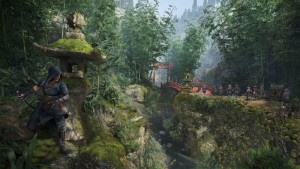Please support Game Informer. Print magazine subscriptions are less than $2 per issue
Get The Most Out Of Assassin’s Creed III

Today marks the release of Assassin’s Creed III, and we suspect a lot of gamers are itching to get home from work or school to get started. The game’s enormous size can be overwhelming; we’ve compiled a list of recommendations, free of spoilers, to help you find your way in the massive game. Check out our advice, and enjoy your trip into the American Revolution and beyond.
Play the Opening Act First
This may seem obvious, but most of us have played Assassin’s Creed games before, and we know the temptation to wander off to explore the world and discover its secrets. Assassin’s Creed III has more of those activities and exploration than any previous game in the series, but you should hold off before seeking them out.
Follow the main story thread all the way up to the end of sequence five before you try and branch out and explore. At this point, many of the optional objectives will appear on the map for the first time, so it’s a better time to poke around in the world. Don’t worry – plenty of opportunities are available after sequence five to complete all the optional objectives and missions in the world.
What is this mysterious opening act? It’s better if you just find out for yourself.
Forget What You Know
Longtime players of Assassin’s Creed will be familiar with a number of fundamentals about how combat and navigation work. While many of those elements remain unchanged, a few features have seen major revision. Pay attention to the tutorials.
In particular, note that traversal now involves holding just one button to sprint, so relax and stop trying to hold down A (360)/X (PS3). Only hold down the button when you want to jump off of a ledge rather than continue at the current elevation.
In addition, take special note of some new controls involved in climbing trees, like the context-sensitive button tap to ascend when you’re standing in the V-shape of a tree.
In combat, try to time your button presses rather than mashing on the buttons. While counters remain a primary way to begin combat interaction, don’t be afraid to open with an offensive defense breaker instead. You can then follow up with a killing blow and mix in some ranged shots. If you don’t have any ammo or you don’t have time to reload, try this strategy: Change to unarmed combat, and counter an enemy to take their rifle. That new rifle usually has a shot loaded in the chamber, ready for you to fire. Finally, watch for firing lines, and always grab a nearby enemy to use as a human shield.
Open Up Fast Travel
Assassin’s Creed III has a big world. Sometimes you’ll want to explore and find new things, but other times you’ll just want to get to the next mission start. To that end, don’t be afraid to utilize fast travel.
The game gives you several fast travel options early, and you should take advantage of them. Your homestead usually has a fast travel marker in front of the main house. Harbormaster icons can also be used to fast travel. In the wilderness, entry points into the Frontier can be fast traveled to at any time. Try to choose a fast travel point that is near your destination, and then use your horse whistle to summon a mount to get you the rest of the way ASAP.
In addition, if you’re interested in exploring the underground labyrinths beneath Boston, and later New York, consider doing so early. By exploring those underground tunnels, you’ll open up numerous fast travel locations in the cities, which will be enormously helpful as you play through the rest of the game.
[Next up: Crafting and trade, and navigating the high seas]

Wrapping Your Head Around Crafting/Trade
Crafting and trade are a little complicated, but here’s some advice to get you started.
Start with your stockpile. To make new items available for purchase, you’ll need to complete homestead missions. As your new villagers advance their respective stories, you’ll gain access to new items. I recommend acquiring a few of every item as you gain access to them, as that will make crafting easier and less time consuming.
Where possible, rather than trade these raw goods, spend some time in your crafting menu to turn those raw goods into valuable merchandise; you’ll see a larger return on your investment. Upgrade your land convoys (and later your naval convoys) as quickly as possible, as that will let you send more items in a single run. Be patient with crafting. Initially, many items will be unavailable until your craftspeople improve (again, through homestead missions) or until you get certain items. Focus on the items you can craft for now, and know you’ll be able to come back later to do more.
Take the time to note which of your items get a good return on the investment. Early on, without even having to touch the crafting menu, one of the best options is buying up and then selling hunting pelts. That said, try to avoid selling items in your trade window that you’ll need in your crafting. For instance, if you need a bunch of barrels to make ale, don’t sell off your entire barrel stock to a trader in Boston. Instead, do crafting first, and then sell the completed product. Be especially wary of selling off items in the “Materials” tab, as those are usually items that are commonly used in crafting recipes.
Different shop owners will offer a different price for different items, so try and find a buyer who offers you a good deal on your best items. However, resist the temptation to send a single convoy to multiple stops, as it usually results in dramatically increased risk and time investment for only moderate monetary gain.
Finally, if you’re seeing a painful tax rate or very high risk for your convoys, take some time to bring down some forts and complete liberation missions on land and privateer missions on the sea to improve those rates. In addition, when your convoys do come under attack, don’t just let that pass, as you’ll completely lose your investment. Instead, hop into your Assassin menu, and send one of your recruits to defend the convoy. If you don’t have any recruits available yet, take the time to fast travel near to your convoy out in the Frontier, and then try to reach it before it’s sacked.
Take To the Seas
Naval missions are a whole new feature to Assassin’s Creed III, and the gameplay mechanic is pretty straightforward. But here are a few things to keep in mind if you start running into trouble.
Your pinpoint swivel gun is generally best used to bring down smaller ships. Save your broadsides for the big fish.
When you do utilize your full cannon, try to hold it down until you have the best shot, keeping in mind that you might need to lead your target a bit to account for distance. Holding the fire button down for a short time will result in a more powerful, focused shot on your target.
Remember that higher speeds result in lower maneuverability, so don’t be afraid to slow down when you need to make a tight turn.
Finally, if you’re really running into trouble, head to your harbormaster at the Homestead and use the book by Faulkner’s side to upgrade your ship. These upgrades are very expensive, but they can be worth it if you’re running into trouble in the water.
[Next up: How to prioritize different activities in the game]

Play For Fun, Not Completion (At Least At First)
Unlike some previous Assassin’s Creed games, the new title allows replays of almost all the content you’d be interested in exploring. For that reason, we recommend playing the story campaign to completion, whether you finish the secondary mission objectives or not. Return later if you fail some of those secondary objectives. The rewards for full synchronization are ultimately minor when balanced against playing through missions the way you want to. Plus, some of the secondary objectives are very challenging or frustrating to complete on your first attempt. You may very well enjoy the game more if you let some of those objectives slide on your first run-through, rather than constantly reloading a challenging section in order to get it right.
Recommended Priorities
Until you dig deep into the game, it’s hard to know which content is definitely worth exploring, and what is only there for true completionists. Here’s our totally unofficial recommendation for how you prioritize content based on the quality and depth of the related story and missions. Stuff at the top is essential to getting the most out of the game. Items at the bottom of the list are less rewarding or interesting, and many players may want to skip or only check them out in a limited way.
Main Story Missions (Including Desmond’s story)
Naval Missions (The main thread has significant story content)
Homestead Missions (Essential for crafting/trading, and filled with lots of fun story moments)
Liberation Missions (Acquiring your Assassin Brotherhood)
Peg Leg Trinkets/Kidd’s Treasure Missions (You need to find the trinkets to complete these enjoyable missions across the eastern seaboard, so the two go hand-in-hand)
Privateer Contracts (Important for improving naval trade)
Crafting/Trading (Important if you want to have a lot of money)
The Underground (Important if you want lots of fast travel destinations)
Forts (Important for more profitable trading)
Viewpoints (Less important than in previous games, since you unlock map areas as you explore them. However, viewpoints will accelerate the process)
Interactive Conversations (Important if you’re interested in learning more about the story)
Clubs (Hunting, Thieving, Frontiersman, etc.)
Exploring the Animus Database (Important if you’re interested in the actual history behind the game)
Assassin Contracts (The missions you send your brotherhood on across the colonies)
Other Collectibles (Feathers, Chests, Almanacs)
Encyclopedia of the Common Man (This homestead activity is far secondary to the main homestead missions)
Citizen Missions (Courier, Delivery, Assassination)
Animus Synching (Only available post-game, and built with completionists in mind)
It’s also worth noting that we highly recommend engaging with the excellent multiplayer component of the game, which is far more rewarding than many of the lesser tasks further down on the above list. Even if you don’t like competitive multiplayer, the excellent Wolfpack mode provides a cooperative mode you can play with your friends.
No matter how you decide to approach Assassin’s Creed III, have a great time! If you missed it, you can read our review of the game right here.










